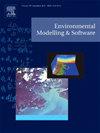随机降水条件下寒区水循环模拟对水田高效用水的调控
IF 4.8
2区 环境科学与生态学
Q1 COMPUTER SCIENCE, INTERDISCIPLINARY APPLICATIONS
引用次数: 0
摘要
寒冷地区独特的冻融循环使灌溉变得复杂。现场监测和实验模拟了解冻期和生长期的水循环,分析了水力联系。将水文平衡模型、环境政策综合气候(EPIC)模型和碳排放模型耦合到水稻灌溉的多目标优化框架中,以实现增产、节水和减排。利用蒙特卡罗模拟和非支配排序遗传算法III (NSGA-III),制定了考虑降水变率的动态水量分配方案。将0 ~ 60 cm土层模拟为连续改良土壤水分模拟,结果表明浸水灌溉节水16% ~ 21.8%。与传统灌溉方式相比,优化后的灌溉方式可使最高单产提高1.6% ~ 4.7%,单位单产碳排放量降低16.4% ~ 18.6%,节水7.7% ~ 9.5%。分蘖期和拔节-孕穗期为关键分配期,优化了57% - 72%的生长期分配,支持了寒冷地区稻田的可持续水资源管理。本文章由计算机程序翻译,如有差异,请以英文原文为准。
Regulation of efficient water use in paddy fields via the simulation of the water cycle in cold regions under random precipitation conditions
The unique freeze‒thaw cycle in cold regions complicates irrigation. Field monitoring and experiments simulated the water cycle during thawing and growing periods, analyzing hydraulic connections. This led to coupling a hydrological balance model, the Environmental Policy Integrated Climate (EPIC) model, and a carbon emission model into a multi-objective optimization framework for rice irrigation, aiming to enhance production, save water, and reduce emissions. Using Monte Carlo simulation and the Non-dominated Sorting Genetic Algorithm III (NSGA-III), dynamic water distribution plans were developed considering precipitation variability. Modeling the 0–60 cm soil layer as continuous improved soil moisture simulation, resulted in soaking irrigation with 16 %–21.8 % water savings. Optimized irrigation increased maximum yield by 1.6 %–4.7 %, reduced carbon emissions per unit yield by 16.4 %–18.6 %, and saved 7.7 %–9.5 % water compared to conventional methods. Key allocation periods are tillering and jointing-booting initiation, optimizing distributions for 57 %–72 % of the growth period, supporting sustainable water management in cold-region rice paddies.
求助全文
通过发布文献求助,成功后即可免费获取论文全文。
去求助
来源期刊

Environmental Modelling & Software
工程技术-工程:环境
CiteScore
9.30
自引率
8.20%
发文量
241
审稿时长
60 days
期刊介绍:
Environmental Modelling & Software publishes contributions, in the form of research articles, reviews and short communications, on recent advances in environmental modelling and/or software. The aim is to improve our capacity to represent, understand, predict or manage the behaviour of environmental systems at all practical scales, and to communicate those improvements to a wide scientific and professional audience.
 求助内容:
求助内容: 应助结果提醒方式:
应助结果提醒方式:


